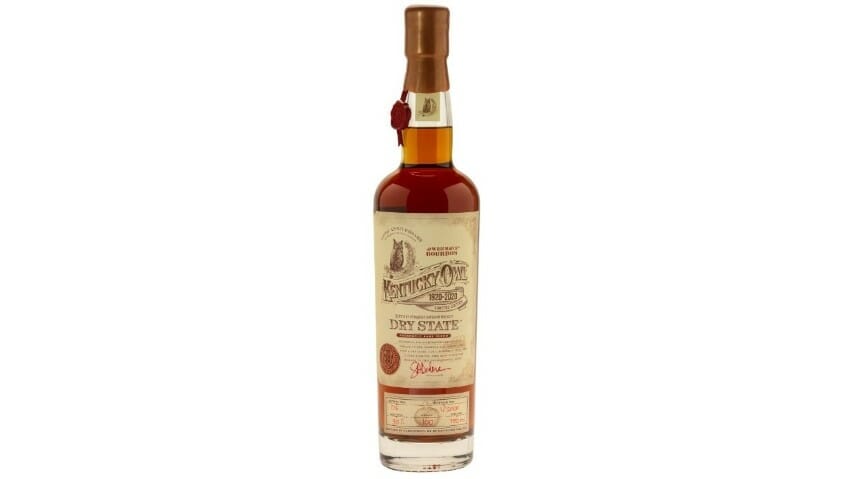Kentucky Owl Dry State Bourbon
Photos via Kentucky Owl
As I sit down to write this review, I’m asking myself a question: Is there anything a bourbon could possibly do, in terms of the liquid in the bottle, to justify an MSRP of $1,000? Is there any combination of age statements, proof points, legendary distillers or special finishes that could make me say “Sure, that’s a reasonable price point”? If it was say, the finest whiskey that Julian “Pappy” Van Winkle ever distilled, would even that command an MSRP of $1,000 … keeping in mind that although Van Winkle bottles are often sold at such prices, the actual MSRPs of the series max out at $300 for Pappy Van Winkle 23 Year?
And the more I think about it, the more I can only conclude that the answer to my question is “no.” There’s just no way you can humanly rationalize an MSRP of $1,000 for a bottle of bourbon, no matter how special that whiskey purports to be. A bourbon with that kind of pricing, by its very nature HAS TO BE the greatest whiskey you’ve ever had. And Kentucky Owl’s new Dry State bourbon, while good, is nowhere near the level of transcendent, mind-bending quality that its crazy, $1,000 price tag would demand. In fact, it’s not even the best bourbon I’ve had from Kentucky Owl in the last few years.
Let us first explain the specs behind Kentucky Owl Dry State, before we sample the liquid and dissect the impossible task of justifying that price tag. This is a limited release blend of bourbons that was created to celebrate the passage of a century since the start of Prohibition in 1920. The company describes this blend as its oldest and “rarest” to date, being a well-aged blend of bourbons between 12 and 17 years old, and bottled at 115 proof. It’s not entirely clear if this is the natural cask strength for the blend, or whether it has been diluted to this particular strength, as recent Kentucky Owl batches have had proof points in the 120s. As with all Kentucky Owl releases, the company doesn’t disclose the source of its whiskeys—as such, it is relying entirely on the reputation of the KO name and whatever hype it has accrued since 2014 to justify the $1,000 price point per bottle. The size of the batch, meanwhile, is 2,000 bottles.
Those are the facts of what this bourbon is, in terms of the liquid in the bottle. In terms of its role to the company, on the other hand, Dry State would appear to be an experiment in extreme premiumization, to see just how high Kentucky Owl can push a price tag. This is a level well beyond the numbers that even the most prized previous Kentucky Owl bottles have fetched on the secondary market.
Perhaps to soften this blow, the company has partnered with auction house Christie’s to auction off a handful of bottles to directly benefit the National Restaurant Association’s Employee Advancement Fund, “a charitable enterprise dedicated to establishing a long-term recovery solution for service industry workers who have had their careers stunted due to the adverse impacts of COVID-19.” These auctions are now live via Christie’s, with starting prices of $1,500, and will continue through Oct. 1. The company’s statement:
“Kentucky Owl Dry State’s release during this centennial anniversary of Prohibition is a reflection on our past, but also an opportunity to support the hardworking men and women affected by the closing of bars and restaurants across the country,” says Dixon Dedman, Kentucky Owl Master Blender. “We’re also proud to work with the National Restaurant Association’s Employee Relief Fund and keep shining a spotlight on the plight of talented restaurant employees, many who are proud stewards of the bourbons we produce in Kentucky.”
Is that nice to see? Sure. Absolutely. Good on them for doing it. If the entire release was for charity, this would make more sense. But we should of course note that this is five bottles of the 2,000 bottle batch. And the rest of them will be sold to the public at $1,000 a piece. So yeah … there’s money being made here, and a price point being set that has essentially almost no comparison outside the world of 40-year-old single malt scotch releases.
-

-

-

-

-

-

-

-

-

-

-

-

-

-

-

-

-

-

-

-

-

-

-

-

-

-

-

-

-

-

-

-

-

-

-

-

-

-

-

-








































